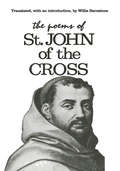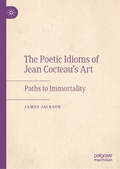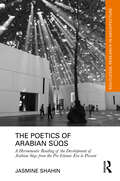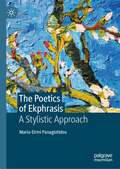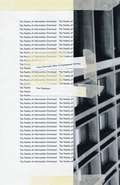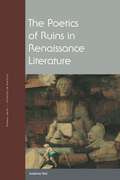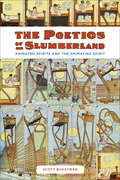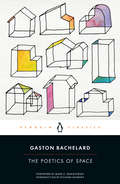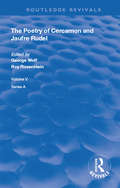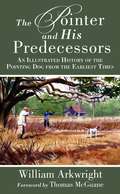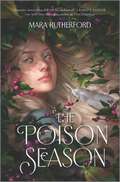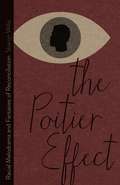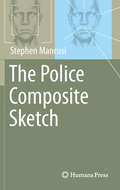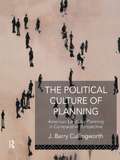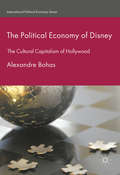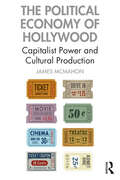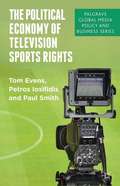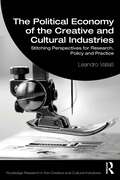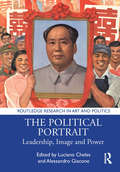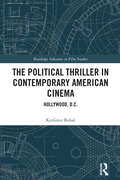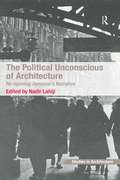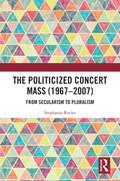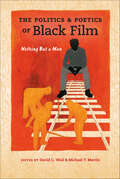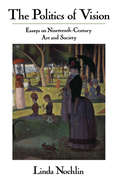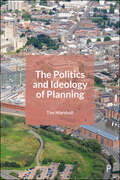- Table View
- List View
The Poems of St. John of the Cross
by Willis BarnstoneSaint John's poetry of love and joy describes the soul's passage through dark night to final illumination in mystical union with Absolute Being. The allegory the poet uses is that of earthly love, and the poems are strikingly effective on the immediate level of personal experience, quite apart from their theological meanings. Many critics regard the work of Saint John of the Cross (1542-91), the 16th-century mystic, to be among the finest poetry Spain has produced. This bilingual edition, the first in modern English, was originally published in hard cover in 1968 by the Indiana University Press. Most of these poems were written during a period of nine months, in 1577-78, when Saint John (San Juan de la Cruz) was imprisoned and tortured in the dungeon of a small Carmelite monastery in Toledo, and their recurrent motifs are both metaphysical and deeply personal.
The Poetic Idioms of Jean Cocteau’s Art: Paths to Immortality
by James JacksonCocteau had an ambition many a poet has: to become immortal. But he, perhaps more than most, addressed this ambition directly in a great many of his plays, poems, and films. This book puts the work of this elusive and compelling poet under the microscope, examining how he channeled the concerns and anxieties of his age (and beyond) into his creations. Putting aside anecdotes of his life and other biographical minutiae, it turns to the creative achievements of the polymath – some well-known, some less so – to examine how he wrestles with the profound questions that concern human nature and enters into a conversation with his creative forebears on matters relating to love, imagination, suffering, and consolation.
The Poetics of Arabian Sūqs: A Hermeneutic Reading of the Development of Arabian Sūqs from the Pre-Islamic Era to Present (Routledge Research in Architecture)
by Jasmine ShahinThis book investigates the history of Arabian sūqs from their pre-Islamic beginnings to the present. Collecting evidence from archaeological ruins, Islamic towns, modern cities, Arabic poetry, philosophical debates, political conflicts, puppet shows and the insights of modern-day market-goers, the book presents new and unforeseen interpretations of the Arabian sūq’s meaning and its transformation through time and place. The finding that such meaning is tied to ancient trade rituals, where temple and market presented a holistic socio-urban unit, re-questions some instrumental assumptions regarding the value of sūq-ness in Arabia’s everyday practices. Such a finding, which locates the fadaā/tareeq duality as a central theme in Arabia’s socio-urban discourse, emphasizes the importance of lived experiences and poetics as key sources for understanding socio-urban phenomena.
The Poetics of Ekphrasis: A Stylistic Approach
by Maria-Eirini PanagiotidouThis book provides a stylistic and cognitive poetic account of ekphrastic poetry (poetry whose subject matter is predominantly artworks and images), examining the linguistic processes through which works of art can become literary objects. The author sheds light on the workings of ekphrasis at a textual level, while also considering the cognitive and psychological effects of reading ekphrastic poems, developing cognitive and stylistic analytical frameworks grounded on the four principles that govern ekphrasis: representation, narrativization, transposition, and collaboration. This book will be of interest to academics and practitioners in various fields, including literary critics, art critics, rhetoricians, poets, visual artists, and stylisticians.
The Poetics of Information Overload: From Gertrude Stein to Conceptual Writing
by Paul StephensInformation overload is a subject of vital, ubiquitous concern in our time. The Poetics of Information Overload reveals a fascinating genealogy of information saturation through the literary lens of American modernism. Although technology has typically been viewed as hostile or foreign to poetry, Paul Stephens outlines a countertradition within twentieth- and twenty-first-century literature in which avant-garde poets are centrally involved with technologies of communication, data storage, and bureaucratic control. Beginning with Gertrude Stein and Bob Brown, Stephens explores how writers have been preoccupied with the effects of new media since the advent of modernism. He continues with the postwar writing of Charles Olson, John Cage, Bern Porter, Hannah Weiner, Bernadette Mayer, Lyn Hejinian, and Bruce Andrews, and concludes with a discussion of conceptual writing produced in the past decade.By reading these works in the context of information systems, Stephens shows how the poetry of the past century has had, as a primary focus, the role of data in human life.
The Poetics of Ruins in Renaissance Literature (Verbal Arts: Studies in Poetics)
by Andrew HuiThe Renaissance was the Ruin-naissance, the birth of the ruin as a distinct category of cultural discourse, one that inspired voluminous poetic production. For humanists, the ruin became the material sign that marked the rupture between themselves and classical antiquity. In the first full-length book to document this cultural phenomenon, Andrew Hui explains how the invention of the ruin propelled poets into creating works that were self-aware of their absorption of the past as well as their own survival in the future.
The Poetics of Slumberland: Animated Spirits and the Animating Spirit
by Scott BukatmanIn The Poetics of Slumberland, Scott Bukatman celebrates play, plasmatic possibility, and the life of images in cartoons, comics, and cinema. Bukatman begins with Winsor McCay's Little Nemo in Slumberland to explore how and why the emerging media of comics and cartoons brilliantly captured a playful, rebellious energy characterized by hyperbolic emotion, physicality, and imagination. The book broadens to consider similar "animated" behaviors in seemingly disparate media--films about Jackson Pollock, Pablo Picasso, and Vincent van Gogh; the musical My Fair Lady and the story of Frankenstein; the slapstick comedies of Jerry Lewis; and contemporary comic superheroes--drawing them all together as the purveyors of embodied utopias of disorder.
The Poetics of Space
by Gaston Bachelard Mark Z. Danielewski Richard Kearney Maria JolasA beloved multidisciplinary treatise comes to Penguin ClassicsRare is the work of philosophy that invites both the casual reader and the academic. Rare, too, is the text so universal that luminaries across an array of fields lay claim to it. <P><P>Yet, that is precisely the case with Gaston Bachelard's The Poetics of Space. A rumination on the spaces we inhabit and the dreams and memories that fill them, this seminal work continues to be studied and enjoyed by philosophers, architects, writers, and literary theorists alike.This new edition features a foreword by Mark Z. Danielewski, whose bestselling novel House of Leaves drew inspiration from Bachelard's writings, and an introduction by internationally renowned philosopher Richard Kearney who explains the book's enduring importance and its role within Bachelard's remarkable career.For more than sixty-five years, Penguin has been the leading publisher of classic literature in the English-speaking world.
The Poetry of Cercamon and Jaufre Rudel (Routledge Revivals)
by George Wolf and Roy RosensteinPublished in 1983, Wolf and Rosenstein have delved into the poetry writings in detail of Cercamon and Jaufre Rudel, with detailed textual notes on the poems, exploring the individual poets' lives and looking at the translation of the writings.
The Pointer and His Predecessors: An Illustrated History of the Pointing Dog from the Earliest Times
by William Arkwright Thomas McGuaneOriginally published in 1906, The Pointer and His Predecessors is a highly researched guide to anything and everything relating to the pointing hunting dog. These hunting dogs primarily fall under the setter and pointer breeds, and Arkwright has included everything that an owner would need to know. Anyone who has any interest in shooting and hunting culture will find this book of substantial use.The Pointer and His Predecessors includes topics such as:Characteristics of the PointerBreeding and SelectionShooting Over DogsBreaking and TrainingKennel ManagementAmidst the plethora of factual information are Arkwright’s own theories and anecdotes on the topic of pointing dogs. Arkwright discusses their origin as he pulls biblical quotes and examples to pinpoint where in history these hunting dogs were first spotted. He also recalls on his own experiences with the hounds to exemplify his passion for game dogs. The Pointer and His Predecessors is the top choice for anyone interested in hunting with dogs.Skyhorse Publishing is proud to publish a broad range of books for hunters and firearms enthusiasts. We publish books about shotguns, rifles, handguns, target shooting, gun collecting, self-defense, archery, ammunition, knives, gunsmithing, gun repair, and wilderness survival. We publish books on deer hunting, big game hunting, small game hunting, wing shooting, turkey hunting, deer stands, duck blinds, bowhunting, wing shooting, hunting dogs, and more. While not every title we publish becomes a New York Times bestseller or a national bestseller, we are committed to publishing books on subjects that are sometimes overlooked by other publishers and to authors whose work might not otherwise find a home.
The Poison Season
by Mara Rutherford"Mara Rutherford&’s The Poison Season took me on journey through a bloodthirsty forest, where two star-crossed lovers discover the true meaning of poison. It brims with evocative storytelling that left me enchanted!" — Emily J. Taylor, New York Times bestselling author of Hotel MagnifiqueOutsiders are always given a choice: the Forest or the lake. Either way, they&’re never heard from again.Leelo has spent her entire life on Endla, coexisting with the bloodthirsty Forest and respecting the poisonous lake that protects her island from outsiders who seek to destroy it. But as much as Leelo cares for her community, she struggles to accept that her younger brother will be exiled by his next birthday, unless he gains the magic of enchanted song so vital to Endla.When Leelo sees a young outsider on the verge of drowning in the lake, she knows exactly what she&’s supposed to do. But in a moment that will change everything, Leelo betrays her family, her best friend, and Endla by making an unthinkable choice.Discovery could lead to devastating consequences for both Leelo and the outsider, Jaren, but as they grow closer, Leelo realizes that not all danger comes from beyond the lake—and they can only survive if Leelo is willing to question the very fabric of her society, her people, and herself.
The Poitier Effect: Racial Melodrama and Fantasies of Reconciliation
by Sharon WillisThe civil rights struggle was convulsing the nation, its violence broadcast into every living room. Against this fraught background, Sidney Poitier emerged as an image of dignity, discipline, and moral authority. Here was the picture-perfect black man, helping German nuns build a chapel in The Lilies of the Field and overcoming the prejudices of recalcitrant students in To Sir with Love, a redneck sheriff in In the Heat of the Night, and a prospective father-in-law in Guess Who&’s Coming to Dinner. In his characters&’ restrained responses to white people&’s ignorance and bad behavior, Poitier represented racial reconciliation and reciprocal respect—the &“Poitier effect&” that Sharon Willis traces through cinema and television from the civil rights era to our own.The Poitier effect, in Willis&’s account, is a function of white wishful thinking about race relations. It represents a dream of achieving racial reconciliation and equality without any substantive change to the white world. This notion of change without change conforms smoothly with a fantasy of colorblindness, a culture in which difference makes no difference. Willis demonstrates how Poitier&’s embodiment of such a fantasy figures in the popular cinema of the civil rights era—and reasserts itself in recent melodramas such as The Long Walk Home, Pleasantville, Far from Heaven, and The Help. From change without change to change we can believe in, her book reveals how the Poitier effect, complicated by contemporary ideas about feminism, sexuality, and privilege, continues to inform our collective memory as well as our visions of a postracial society.
The Police Composite Sketch
by Stephen MancusiThe police composite sketch, one of the most crucial investigative tools in law enforcement, is developed during a composite session--an intense display of communication and art in which the words of a witness are transformed into the features of a suspect. Despite the incredible technological leaps made in investigative work, the forensic science of composite sketching still relies on the basic elements of drawing skill, interpretive ability and the spoken word. The Police Composite Sketch is a comprehensive manual on how to conduct a complete composite session. Through an array of case studies, it details several disciplines that comprise this specialized forensic art, including composite sketching, image modification, age progression, facial comparison analysis, demonstrative evidence and postmortem/skull reconstruction. It also explores how to intuit insights that are often inadvertently revealed by witnesses, victims and perpetrators during the composite session. In addition, this book discusses other relevant topics, such as the three-stage drawing technique, witness and victim types, descriptive terminologies, managing composite sessions. Complete with numerous illustrations and drawing tips, this seminal work offers a general composite session philosophy and specific session strategies to both experienced and aspiring forensic artists as well as any lay reader intrigued by this fascinating skill.
The Political Culture of Planning: American Land Use Planning in Comparative Perspective
by J. Barry Cullingworth J Barry CullingworthFirst published in 1993. Routledge is an imprint of Taylor & Francis, an informa company.
The Political Economy of Disney
by Alexandre BohasThis book sheds new light on the socio-economic impact of multinational corporations. Combining Cultural Studies and International Political Economy, it provides a revealing analysis of the Walt Disney Company, and by extension the wider Hollywood studio system. It does so by examining the cultural and economic forces powering the industry's expansion, the 'civilisation' that Disney disseminates, and the various ways that societies beyond the USA have adopted facets of the Hollywood productions to which they are exposed. Identifying both the strengths and the weaknesses of these transnational firms, it demonstrates the significance of their contribution to American power and predominance.
The Political Economy of Hollywood: Capitalist Power and Cultural Production
by James McMahonIn Hollywood, the goals of art and business are entangled. Directors, writers, actors, and idealistic producers aspire to make the best films possible. These aspirations often interact with the dominant firms that control Hollywood film distribution. This control of distribution is crucial as it enables the firms and other large businesses involved, such as banks that offer financing, to effectively stand between film production and the market. This book analyses the power structure of the Hollywood film business and its general modes of behaviour. More specifically, the work analyses how the largest Hollywood firms attempt to control social creativity such that they can mitigate the financial risks inherent in the art of filmmaking. Controlling the ways people make or watch films, the book argues, is a key element of Hollywood’s capitalist power. Capitalist power—the ability to control, modify, and, sometimes, limit social creation through the rights of ownership—is the foundation of capital accumulation. For the Hollywood film business, capitalist power is about the ability of business concerns to set the terms that will shape the future of cinema. For the major film distributors of Hollywood, these terms include the types of films that will be distributed, the number of films that will be distributed, and the cinematic alternatives that will be made available to the individual moviegoer. Combining theoretical analysis with detailed empirical research on the financial performance of the major Hollywood film companies, the book details how Hollywood’s capitalist goals have clashed with the aesthetic potentials of cinema and ultimately stymied creativity in the pursuit of limiting risk. This sharp critique of the Hollywood machine provides vital reading for students and scholars of political economy, political theory, film studies, and cinema.
The Political Economy of Television Sports Rights
by Paul Smith Tom Evens Petros IosifidisSport on television is big business. Broadcasters across the world regularly agree highly lucrative deals for the television broadcast rights to cover major sporting events or competitions. At the same time, however, sport is about more than just commerce. Sport is a social and cultural activity practiced and valued by millions of people throughout the world. The Political Economy of Sports Rights examines both the economic and the social significance of sports broadcasting, as well as how each of these contrasting perspectives have led to the extensive regulation of sports broadcasting by national governments and, in the case of many European countries, the European Union. Using a range of national case studies from Europe and beyond, this book highlights the need for a regulatory approach to sports broadcasting that balances the commercial priorities of sports organisations and private media companies with the wider social and cultural benefits to be gained from free-to-air sports broadcasting.
The Political Economy of the Creative and Cultural Industries: Stitching Perspectives for Research, Policy and Practice (Routledge Research in the Creative and Cultural Industries)
by Leandro ValiatiThe creative and cultural industries (CCIs) are often seen by markets as critical drivers of economic growth and by governments as feasible ways to foster development. The link between these two perspectives lies in the CCIs’ capacity to generate both economic value and social innovation simultaneously. While markets value their direct contribution to GDP and employment, governments recognise their potential to catalyse broader societal development through cultural expression, innovation and community engagement.Divided into key sections covering theoretical foundations, economic growth and development, innovation, policy and data analysis, this book presents a multifaceted view of CCIs’ role in modern economies and societies. It challenges traditional economic models, advocates for a holistic approach to socio‑economic development and examines the transformative impact of digital technologies on creative work. This work makes significant contributions to the field by advancing the political economy of CCIs, synthesising current debates and clarifying critical concepts. It explores innovative approaches to measuring the economic impact of CCIs and proposes a roadmap for harnessing their full potential in driving sustainable and inclusive growth. With its flexible structure allowing for customised learning experiences, this book is an essential resource for understanding the complexities of creative industries in our rapidly changing world.This interdisciplinary volume bridges theory and practice, providing invaluable insights relevant to students of CCIs, economics, arts and cultural management, as well as for academics, policymakers and practitioners.
The Political Portrait: Leadership, Image and Power (Routledge Research in Art and Politics)
by Luciano Cheles Alessandro GiaconeThe leader's portrait, produced in a variety of media (statues, coins, billboards, posters, stamps), is a key instrument of propaganda in totalitarian regimes, but increasingly also dominates political communication in democratic countries as a result of the personalization and spectacularization of campaigning. Written by an international group of contributors, this volume focuses on the last one hundred years, covering a wide range of countries around the globe, and dealing with dictatorial regimes and democratic systems alike. As well as discussing the effigies that are produced by the powers that be for propaganda purposes, it looks at the uses of portraiture by antagonistic groups or movements as forms of resistance, derision, denunciation and demonization. This volume will be of interest to researchers in visual studies, art history, media studies, cultural studies, politics and contemporary history.
The Political Thriller in Contemporary American Cinema: Hollywood, D.C. (Routledge Advances in Film Studies)
by Krešimir BobašThe Political Thriller in Contemporary American Cinema examines how political thriller films (de)construct and reflect the sociopolitical realities of the second half of the twentieth century, as well as the first two decades of the twenty-first century.The book highlights the convergence between the cinematic narrative, its underlying political discourse, and the audience’s perception of it. Through a critical lens, it analyzes how contemporary films utilize characterization, narrative, and suspense to examine topics of governance, malfeasance, and power dynamics. By referring to films such as The Manchurian Candidate, Zero Dark Thirty, and Snowden, this book traces the evolution of the political thriller, questioning how its narratives mirror issues such as covert operations, the erosion of democracy, and governmental surveillance. In turn, the conspiratorial and underlying paranoid nature of these films serves as a reflection of societal anxieties and a metaphorization of the levers of power in America’s modern-day democracy.Consequently, this book serves as a contribution to the growing body of research on political cinema and the way it simultaneously reflects and shapes political life through its role as a sociocultural phenomenon. In doing so, it invites readers to further delve into the exploration of these films, which represent complex commentaries on the structures of corporations, media, and the military that are predominant in contemporary American society and cinema.
The Political Unconscious of Architecture: Re-opening Jameson's Narrative (Ashgate Studies In Architecture Ser.)
by Nadir LahijiThirty years have passed since eminent cultural and literary critic Fredric Jameson wrote his classic work, The Political Unconscious: Narrative as a Socially Symbolic Act, in which he insisted that 'there is nothing that is not social and historical - indeed, that everything is "in the last analysis" political'. Bringing together a team of leading scholars including Slavoj Zizek, Joan Ockman, Jane Rendell, and Kojin Karatani, this book critically examines the important contribution made by Jameson to the radical critique of architecture over this period, highlighting its continued importance to contemporary architecture discourse. Jameson's notion of the 'political unconscious' represents one of the most powerful notions in the link between aesthetics and politics in contemporary discourse. Taking this, along with other key concepts from Jameson, as the basis for its chapters, this anthology asks questions such as: Is architecture a place to stage 'class struggle'?, How can architecture act against the conditions that 'affirmatively' produce it? What does 'the critical', and 'the negative', mean in the discourse of architecture? and, How do we prevent architecture from participating in the reproduction of the cultural logic of late capitalism? This book breaks new ground in architectural criticism and offers insights into the interrelationships between politics, culture, space, and architecture and, in doing so, it acts as a counter-balast to the current trend in architectural research where a general aestheticization dominates the discourse.
The Politicized Concert Mass (1967-2007): From Secularism to Pluralism
by Stephanie RockeSince the transformative 1960s, concert masses have incorporated a range of political and religious views that mirror their socio-cultural context. Those of the long 1960s (c1958-1975) reflect non-conformism and social activism; those of the 1980s, environmentalism; those of the 1990s, universalism; and those of the 2000s, cultural pluralism. Despite utilizing a format with its roots in the Roman Catholic liturgy, many of these politicized concert masses also reflect the increasing religious diversification of Western societies. By introducing non-Catholic and often non-Christian beliefs into masses that also remain respectful of Christian tradition, composers in the later twentieth century have employed the genre to promote a conciliatory way of being that promotes the value of heterogeneity and reinforces the need to protect the diversity of musics, species and spiritualities that enrich life. In combining the political with the religious, the case studies presented pose challenges for both supporters and detractors of the secularization paradigm. Overarchingly, they demonstrate that any binary division that separates life into either the religious or the secular and promotes one over the other denies the complexity of lived experience and constitutes a diminution of what it is to be human.
The Politics & Poetics of Black Film: Nothing But a Man (Studies in the Cinema of the Black Diaspora)
by Michael T. Martin David C. WallWritten and directed by two white men and performed by an all-black cast, Nothing But a Man (Michael Roemer, 1964) tells the story of a drifter turned family man who struggles with the pressures of small-town life and the limitations placed on him and his community in the Deep South, an area long fraught with racism. Though unmistakably about race and civil rights, the film makes no direct reference to the civil rights movement. Despite this intentional absence, contemporary audiences were acutely aware of the social context for the film's indictment of white prejudice in America. To help frame and situate the film in the context of black film studies, the book gathers primary and secondary resources, including the original screenplay, essays on the film, statements by the filmmakers, and interviews with Robert M. Young, the film's producer and cinematographer, and Khalil Gibran Muhammad, the Director of the Schomburg Center for Research in Black Culture.
The Politics Of Vision: Essays On Nineteenth-century Art And Society (Icon Editions Series)
by Linda NochlinA leading critic and historian of nineteenth-century art and society explores in nine essays the interaction of art, society, ideas, and politics.
The Politics and Ideology of Planning
by Tim MarshallPlanning is a battleground of ideas and interests, perhaps more visibly and continuously than ever before in the UK. These battles play out nationally and at every level, from cities to the smallest neighbourhoods. Marshall goes to the root of current planning models and exposes who is acting for what purposes across these battlegrounds. He examines the ideological structuring of planning and the interplay of political forces which act out conflicting interest positions. This book discusses how structures of planning can be improved and explores how we can generate more effective political engagements in the future.
